
A satellite may become charged due to different physical phenomenon. The photoelectric effect (sunlight) may cause charging. If the satellite is orbiting in a high electron flux, it may acquire charge from the space environment. Satellites in geosynchronous orbits are particularly susceptible to this phenomenon due to their location at the edge of the outer radiation belt. This belt is predominantly populated by electrons. Charging may be differential surface charging or it may be internal charging of dielectrics (insulators) within the satellite. The latter is more difficult to design against.

If the charge on a satellite reaches a critical value, then a discharge can occur which may cause damage to one or more of the satellite systems. Of particular concern is the phenomenon termed Deep Dielectric Discharge (DDD). In a flux of high energy electrons, the electrons penetrate the spacecraft outer surface and bury themseleves in dielectric materials such as circuit boards, cable wraps, feedthroughs and the insulation around cables. The buildup of charge will continue until the dielectric strength of the material is exceeded (typically in excess of 100,000 V/cm), when a sudden electrical discharge will occur. This miniature lightning stroke can cause permanent damage in the associated or nearby circuitry.
Various satellites have been designed specifically to explore this phenomenon, and various space weather forecasters have developed rules and models to predict DDD. USAF satellite operators are issued warnings when the daily electron fluence >2 MeV (electrons/sq cm/steradian/day) at geosynchronous orbit meets either of the following conditions:
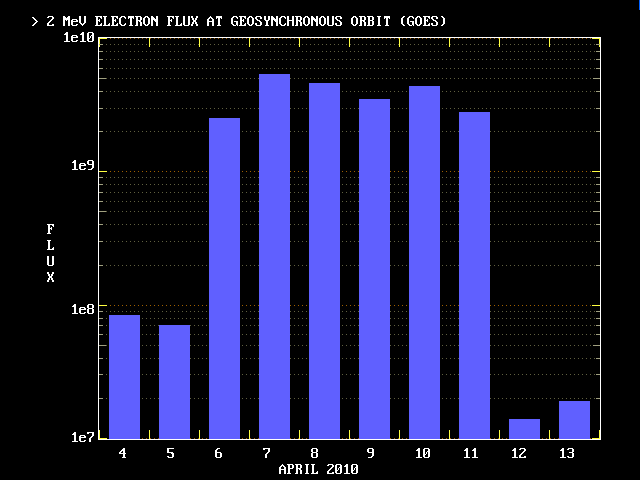
A recent paper in the Space Weather Journal provides some information on which a simple model for predicting DDD can be based. Baker et al (1) provide the experimental results for a DDD event as a function of electron fluence >300 keV from the SCATHA satellite, near geosynchronous orbit. The graph, which is drawn from the results of Vampola is shown below:
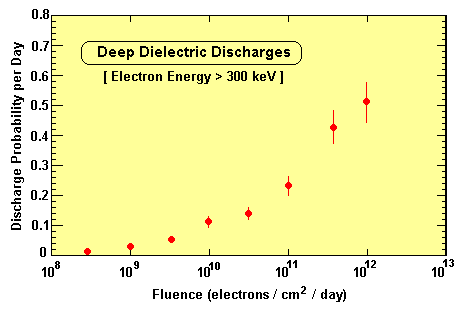
Now, the GOES electron fluence, which the Space Weather Prediction Center in Boulder, Colorado reports on their web site daily is for the electron fluence > 2 MeV. For the above graph to be useful, we must find a relation between the >300 keV and the 2 MeV electron populations. The AE-8 electron radiation belt model is the one most commonly used for examining radiation belt electron fluxes at this time. An examination of this model shows that the relation between the two fluxes is not a simple one, and varies with position in the radiation belt. However, at an L value of 6.6, which is where the geosynchronous orbit lies, the flux of >2 MeV electrons is typically two orders of magnitude below the >300 kev flux.
For this model we have thus shifted the fluence axis by two orders of magnitude and then fitted a Lorentzian growth curve to the points to produce the model algorithm. The graphical model is shown below:
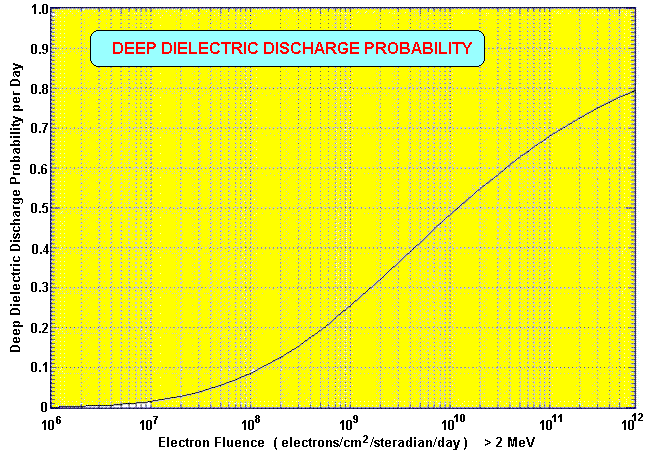
This curve can be expressed mathematically by the formula:
where φ = log10( fluence ) - 5
The occurrence of a deep dielectric discharge on a particular satellite will depend on the actual configuration of and the electronics in the satellite. Engineering techniques employed in the construction of a satellite can make it more or less susceptible to DDD. For this reason, it is probably best to term the probability computed in this model the normalised (or standardised) daily probability of a DDD occurring given a specified electron fluence.
Implementation of the model requires the fluence to be input from the GOES satellite daily measured value. The formula above is then employed to calculate a single daily normalised probability of DDD for a satellite in geosynchronous orbit (where the fluence was measured).
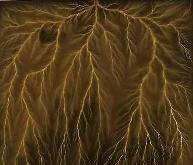
| When relativistic electrons penetrate into a dielectric (the specimen shown at left is a transparent acrylic to reveal the nature of the discharge) they create a cloud of negative charge within the material. This is trapped within the insulator. As the charge increases the electric field also increases and eventually overcomes the dielectric strength of the material. The bonds that hold the molecules together are ripped apart. This creates more ionisation in a chain reaction and within nanoseconds electrically conductive channels with a fork-like structure are created that allow the charge to discharge out of the material. This leaves permanent damage to the dielectric. An electromagnetic pulse is also created by this discharge current, and this may damage nearby sensitive components such as transistors or integrated circuits. (Image credit: Surrey Satellite Centre) |
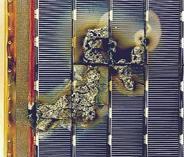 | The image at left shows damage to a panel of the European Space Agency Retrievable Carrier (EURECA). This electrostatic discharge and arcing may have been caused by satellite surface charging rather than interior dielectric charging. It is not always possible to distinguish between the two when the satellite is not able to be inspected. It has been estimated that 54 percent of spacecraft anomalies are caused by electrostatic discharging and charging. (Image credit: ESA) |
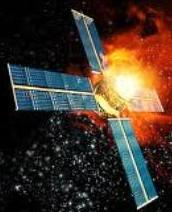 | An artist's impression of the worst case scenario of a spacecraft electrostatic discharge. The discharge extends beyond the confines of the dielectric and ignites fumes from the attitude thrusters. The satellite is totally destroyed. While this may be a very unlikely situation, at least four satellites are now thought to have been rendered totally non-functional through the charging-discharging phenomenon. |
References
D N Baker, S G Kanekal and J B Blake, "Characterizing the Earth's outer Van Allen zone using a radiation belt content index", Space Weather, v2, S02003, doi:10.1029/2003SW000026, 2004.
 Australian Space Academy
Australian Space Academy